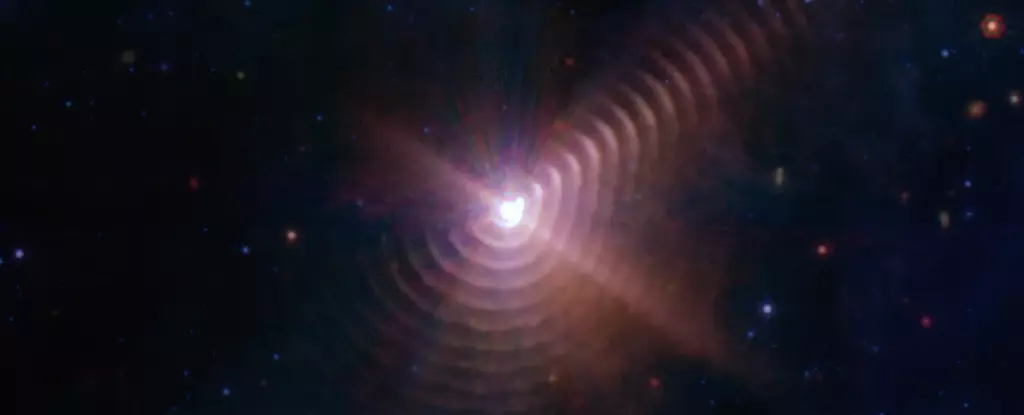Cosmic dust, a rich amalgam of carbon and other elements, plays a critical role in the cosmos, serving as a foundational building block for life and the formation of rocky planets. While often overlooked, this dust is integral to the chemical evolution of galaxies and the development of habitable environments. The study of cosmic dust finds heightened importance in the astronomical community, particularly as advanced telescopes like the James Webb Space Telescope (JWST) unveil new truths about our universe. However, the journey to understanding this dust is a challenging one; astronomers frequently face obstacles posed by thick dust clouds that limit their visibility into the depths of space. Navigating through these obstructions is necessary, and JWST’s innovative infrared capabilities have made substantial strides in exploring the dust-laden cosmos.
At the forefront of this cosmic exploration is the Wolf-Rayet binary system, WR 140, located approximately 5,000 light-years away in the constellation Cygnus. This intriguing celestial pair has garnered attention from researchers as it acts as a natural experimental lab for studying the dynamics of dust formation. Recent studies revealed that the powerful stellar winds emitted from both the Wolf-Rayet star and its companion OB star collide in a spectacular display, creating discrete rings of carbon-rich dust. As documented in a 2022 publication in Nature Astronomy, these interactions occur predictably every 7.93 years, making WR 140 the perfect target for scrutinizing the complex phenomenon of dust formation in the interstellar medium.
The research highlighted that while the physical processes of dust production have been theorized, the intricate details regarding the chemical composition and lifecycle of this carbon-rich dust remain poorly understood. The authors of the study stressed that WR 140 allows astronomers to delve into these unknowns, particularly during the periastron passage, the point at which the stars are closest to each other.
The Chaotic Environment Around WR 140
The environment surrounding WR 140 is non-trivial; the stellar winds are chemically rich, and when the send winds make contact, violent collisions ensue. The heated gas exchanges energy, and extraordinary amounts of dust are produced. This dust formation is not random—it follows a systematic pattern driven by the binary stars’ orbital mechanics, providing astronomers with valuable insight into cosmic processes. The past few years have proven particularly fruitful in advancing our knowledge about this binary system, with JWST capturing striking images that convey the significant expansion of these dust rings over relatively short timeframes—often less than two years.
According to Emma Lieb, a key researcher involved in the current studies, the JWST’s observations confirm the reality of the dust shells and reveal that they are expanding at consistent rates. The ability to witness observable changes within such brief intervals is a rarity in astronomical observations, which typically span millennia. This fact underscores the exceptional nature of WR 140, where powerful forces generate evidence of rapid evolution in the dust environment.
The Challenge and Beauty of Monitoring Dust Formation
Observing the cycle of dust production in WR 140 poses a considerable challenge for astronomers, primarily due to the fluctuations of the binary stars’ orbits. Unlike most Wolf-Rayet binaries, which may produce carbon-rich dust less frequently or in less distinct forms, WR 140 presents a remarkably dynamic system that astronomers can monitor closely. The collaboration of entities like the University of Denver has yielded a comprehensive view of how these stellar interactions inform our understanding of galactic dust production.
Astrophysicists such as Jennifer Hoffman have emphasized the significance of these observations; they fundamentally alter our perception of cosmic events, culminating in a better understanding of how massive binary stars can substantially contribute to dust enrichment of the universe. The enhanced resolution provided by JWST is paving the way for studying phenomena that could profoundly influence galactic evolution.
The quest for understanding the cosmic dust generated by WR 140 extends beyond mere scientific curiosity; it has profound ramifications for our comprehension of life’s origins. The carbon-rich debris formed in such environments could play a pivotal role in the development of organic materials necessary for life. As telescopes like JWST continue their observational campaigns, researchers anticipate unveiling more breakthroughs that could reshape our theories of the early universe.
Moreover, the granularity of the JWST’s observations is allowing scientists not only to track the creation of dust over time but also to discern the different forms that this dust takes, some of which can exceed the dimensions of our entire solar system. As scientists unravel the complexities of these dust rings and clouds, they are piecing together a greater narrative about the life cycle of stars and the fundamental processes influencing the cosmos.
The exploration of WR 140 and systems like it will undoubtedly enhance our understanding of cosmic evolution, offering compelling evidence for the remarkable ability of the universe to generate essential compounds for life through phenomenal processes over astronomical timescales. With JWST’s capabilities, the next chapter in understanding the roots of cosmic dust is just beginning, ensuring that our grasp of the universe continues to expand.


Leave a Reply